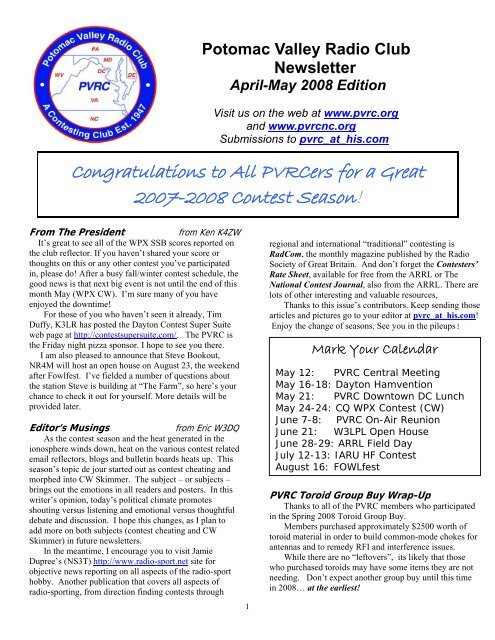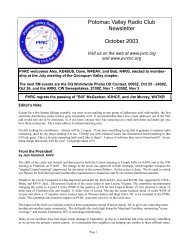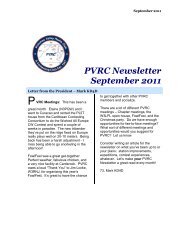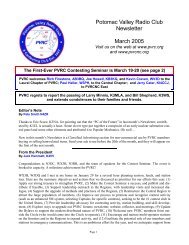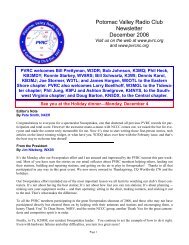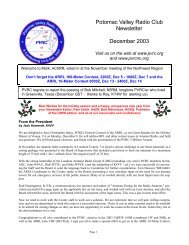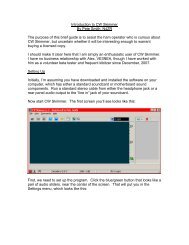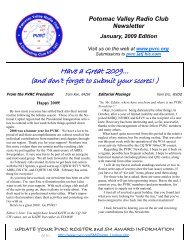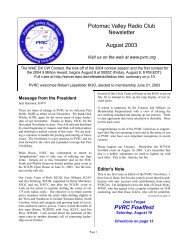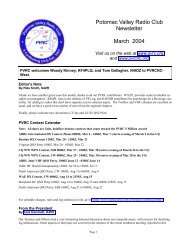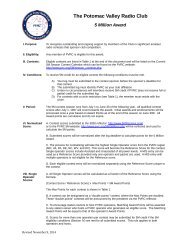Congratulations to All PVRCers for a Great 2007-2008 Contest ...
Congratulations to All PVRCers for a Great 2007-2008 Contest ...
Congratulations to All PVRCers for a Great 2007-2008 Contest ...
You also want an ePaper? Increase the reach of your titles
YUMPU automatically turns print PDFs into web optimized ePapers that Google loves.
Edi<strong>to</strong>r’s Note<br />
Po<strong>to</strong>mac Valley Radio Club<br />
Newsletter<br />
April-May <strong>2008</strong> Edition<br />
Visit us on the web at www.pvrc.org<br />
and www.pvrcnc.org<br />
Submissions <strong>to</strong> pvrc_at_his.com<br />
<strong>Congratulations</strong> <strong>to</strong> <strong>All</strong> <strong>PVRCers</strong> <strong>for</strong> a <strong>Great</strong><br />
<strong>2007</strong>-<strong>2008</strong> <strong>Contest</strong> Season!<br />
From The President<br />
from Ken K4ZW<br />
It’s great <strong>to</strong> see all of the WPX SSB scores reported on<br />
the club reflec<strong>to</strong>r. If you haven’t shared your score or<br />
thoughts on this or any other contest you’ve participated<br />
in, please do! After a busy fall/winter contest schedule, the<br />
good news is that next big event is not until the end of this<br />
month May (WPX CW). I’m sure many of you have<br />
enjoyed the downtime!<br />
For those of you who haven’t seen it already, Tim<br />
Duffy, K3LR has posted the Day<strong>to</strong>n <strong>Contest</strong> Super Suite<br />
web page at http://contestsupersuite.com/. The PVRC is<br />
the Friday night pizza sponsor. I hope <strong>to</strong> see you there.<br />
I am also pleased <strong>to</strong> announce that Steve Bookout,<br />
NR4M will host an open house on August 23, the weekend<br />
after Fowlfest. I’ve fielded a number of questions about<br />
the station Steve is building at “The Farm”, so here’s your<br />
chance <strong>to</strong> check it out <strong>for</strong> yourself. More details will be<br />
provided later.<br />
Edi<strong>to</strong>r’s Musings<br />
from Eric W3DQ<br />
As the contest season and the heat generated in the<br />
ionosphere winds down, heat on the various contest related<br />
email reflec<strong>to</strong>rs, blogs and bulletin boards heats up. This<br />
season’s <strong>to</strong>pic de jour started out as contest cheating and<br />
morphed in<strong>to</strong> CW Skimmer. The subject – or subjects –<br />
brings out the emotions in all readers and posters. In this<br />
writer’s opinion, <strong>to</strong>day’s political climate promotes<br />
shouting versus listening and emotional versus thoughtful<br />
debate and discussion. I hope this changes, as I plan <strong>to</strong><br />
add more on both subjects (contest cheating and CW<br />
Skimmer) in future newsletters.<br />
In the meantime, I encourage you <strong>to</strong> visit Jamie<br />
Dupree’s (NS3T) http://www.radio-sport.net site <strong>for</strong><br />
objective news reporting on all aspects of the radio-sport<br />
hobby. Another publication that covers all aspects of<br />
radio-sporting, from direction finding contests through<br />
1<br />
regional and international “traditional” contesting is<br />
RadCom, the monthly magazine published by the Radio<br />
Society of <strong>Great</strong> Britain. And don’t <strong>for</strong>get the <strong>Contest</strong>ers’<br />
Rate Sheet, available <strong>for</strong> free from the ARRL or The<br />
National <strong>Contest</strong> Journal, also from the ARRL. There are<br />
lots of other interesting and valuable resources,<br />
Thanks <strong>to</strong> this issue’s contribu<strong>to</strong>rs. Keep sending those<br />
articles and pictures go <strong>to</strong> your edi<strong>to</strong>r at pvrc_at_his.com!<br />
Enjoy the change of seasons. See you in the pileups!<br />
Mark Your Calendar<br />
May 12: PVRC Central Meeting<br />
May 16-18: Day<strong>to</strong>n Hamvention<br />
May 21: PVRC Down<strong>to</strong>wn DC Lunch<br />
May 24-24: CQ WPX <strong>Contest</strong> (CW)<br />
June 7-8: PVRC On-Air Reunion<br />
June 21: W3LPL Open House<br />
June 28-29: ARRL Field Day<br />
July 12-13: IARU HF <strong>Contest</strong><br />
August 16: FOWLfest<br />
PVRC Toroid Group Buy Wrap-Up<br />
Thanks <strong>to</strong> all of the PVRC members who participated<br />
in the Spring <strong>2008</strong> Toroid Group Buy.<br />
Members purchased approximately $2500 worth of<br />
<strong>to</strong>roid material in order <strong>to</strong> build common-mode chokes <strong>for</strong><br />
antennas and <strong>to</strong> remedy RFI and interference issues.<br />
While there are no “lef<strong>to</strong>vers”, its likely that those<br />
who purchased <strong>to</strong>roids may have some items they are not<br />
needing. Don’t expect another group buy until this time<br />
in <strong>2008</strong>… at the earliest!
CW Skimmer News<br />
from Pete N4ZR<br />
Reverse Beacon Network - April 18<br />
The reverse beacon network has started <strong>to</strong> take off. As<br />
I write this, we have 8 CW Skimmer reverse beacons<br />
active, and 14 have been on the network in the last 24<br />
hours. 20 and 40 meters are currently covered, and<br />
stations are active in the US east coast and midwest, as<br />
well as northern and southern Europe. The US west coast<br />
came on last night, and will be back. I have a promise that<br />
a station will be activated in VK-land soon.<br />
Reverse beacons come and go at will. The network is<br />
constantly changing. You can find out which reverse<br />
beacons are active by going <strong>to</strong><br />
http://skimmer.dxwatch.com/skimmers.php. See the spots<br />
pour in at http://skimmer.dxwatch.com.<br />
Felipe, PY1NB has also activated a pretty<br />
sophisticated query capability on the main site at<br />
http://skimmer.dxwatch.com/ With a little thought, you<br />
can find out what is being heard by a given reverse beacon,<br />
by whom, on what bands, etc. For example, you can see<br />
what European stations were heard first on a given band on<br />
a given day in the US - F5RRS opened the 20M band<br />
<strong>to</strong>day, all up and down the East Coast.<br />
A couple of notes <strong>for</strong> prospective participants:<br />
-- A wide-band receiver is not absolutely required <strong>to</strong> try<br />
out the reverse beacon idea. Download and install a trial<br />
copy of Skimmer 1.1 (you can do this again even if you<br />
downloaded a trial copy of version 1.0) from<br />
www.dxatlas.com. Download the "aggrega<strong>to</strong>r" from<br />
http://skimmer.dxwatch.com/downloads/skimmer_aggrega<br />
<strong>to</strong>r.zip. Connect a cable from the audio of your transceiver<br />
<strong>to</strong> the Line In jack on your sound card (any old sound card<br />
will work <strong>for</strong> this).<br />
Run Skimmer and set it up in 3-KHz radio mode. Fill<br />
in the opera<strong>to</strong>r tab. Tune your radio <strong>to</strong> an area of activity<br />
on any band, and you should see CW streams on the<br />
Skimmer waterfall. Start the aggrega<strong>to</strong>r, and your spots<br />
will go <strong>to</strong> the network - that's all there is <strong>to</strong> it.<br />
One caution - Skimmer works best if you use its<br />
frequency controls <strong>to</strong> change your radio's frequency - you<br />
will have <strong>to</strong> set up Omni-Rig <strong>for</strong> your radio, on the CAT<br />
tab in Skimmer's settings, and set up <strong>for</strong> computer control<br />
of your radio if you don't already have one. My<br />
experiments suggest that if you tune your radio with that<br />
big knob in the middle you will have <strong>to</strong> s<strong>to</strong>p and wait a bit<br />
be<strong>for</strong>e Skimmer gets sorted out and starts decoding<br />
properly again.<br />
Be sure you enter a 6-character grid square in the<br />
location field of the Opera<strong>to</strong>r tab in Skimmer. We will fix<br />
this, but <strong>for</strong> the moment, if you do not have a full 6-<br />
character grid, your spots will not be displayed by the<br />
server. If you don't know the last 2 characters of your<br />
grid, just use XX.<br />
See you on the reverse beacon network?<br />
Reverse Beacon Network Going Graphical - May 1<br />
Felipe, PY1NB has been busy this week. The main page<br />
of the CW Skimmer reverse beacon network server<br />
http://skimmer.dxwatch.com/ now displays a world map<br />
on which all active "reverse beacons" are shown as green<br />
dots, DX spotted by the CW Skimmers is shown as orange<br />
dots, and the paths between the "spotter" and "spotted" are<br />
shown. You can mouse over either the DX or beacon dots<br />
<strong>to</strong> see what station it is, and the paths are color-coded by<br />
band. You can also set the spot lifetime anywhere from 15<br />
seconds <strong>to</strong> 10 minutes - if a station is still being heard on<br />
the same frequency, Skimmer renews the spot every 10<br />
minutes. Because the service is based on Google Maps,<br />
you can zoom in close. With a short spot lifetime and a<br />
busy band, the site almost provides an animation of the<br />
propagation.<br />
There are still a few known issues on the page,<br />
reflecting its beta status. For example, although the<br />
"beacons" are accurately located, spots in any given<br />
country are still shown in an arbitrary location near the<br />
center of the country; Felipe is studying the feasibility of<br />
doing a QRZ lookup and then locating them more<br />
precisely. The great circle paths are still a little lumpy,<br />
and the mouse-over function is a little twitchy. When you<br />
change the spot lifetime, the lifetime of all spots is<br />
reset <strong>to</strong> the new value, even if they were originally much<br />
older, so it takes a little while <strong>to</strong> settle out. Look <strong>for</strong><br />
additional functionality in the next few weeks, and if you<br />
see Felipe in Day<strong>to</strong>n, say hi and tell him you appreciate all<br />
his work.<br />
Meanwhile, the reverse beacon network still needs<br />
additional CW Skimmers operating on more bands and in<br />
more locations. For example, every morning I spot VK<br />
and ZL stations on 40M. I wonder what the VKs and ZLs<br />
are hearing, on that or any other band. Who'll be the first<br />
reverse beacon in JA, or BY, or HL?<br />
A “Classic <strong>Contest</strong>”<br />
from Frank W3LPL<br />
[<strong>for</strong> all the talk about CW Skimmer and new<br />
technology,, W3LPL points out this contest,<br />
sponsored by the Straight Key Century Club, SKCC-<br />
W3DQ]<br />
Now, here's the contest that the technology averse<br />
among us have been dreaming of! No keyers and no<br />
computer keying; just straight keys, bugs or sideswipers!<br />
The rules are available on the SKCC website:<br />
http://www.skccgroup.com/sprint/sprint-rules.htm<br />
Can't make it this month? No worries. Straight Key<br />
Sprints take place on the fourth Wednesday of every<br />
month from 0100z <strong>to</strong> 0300z!<br />
2
VHF & Above News<br />
from Jamie NS3T<br />
PVRC Excels In <strong>2007</strong> September VHF QSO Party<br />
Led by the <strong>to</strong>p overall score from the Grid Pirates at<br />
K8GP, PVRC won the Club Competition of the <strong>2007</strong><br />
September ARRL VHF QSO Party.<br />
K8GP led all scores with 1.37 million points, beating<br />
out Massachusetts multi-op power W2SZ. The other big<br />
chunk of club points came from David Petke K1RZ, who<br />
finished second in the Single Op High Power category<br />
behind winner K1TEO.<br />
PVRC submitted 21 logs, exactly the same as the<br />
North East Weak Signal group - and we came out ahead by<br />
only 26,818 points. The club needed every possible point,<br />
so, congrats <strong>to</strong> everyone who submitted their log!<br />
In <strong>2007</strong>, PVRC won the club competition in two of the<br />
three ARRL VHF events (June and September) and<br />
finished third in the January VHF, in which K8GP did not<br />
compete.<br />
The <strong>2008</strong> June ARRL VHF is one month away, which<br />
gives you some – but not much -- time <strong>to</strong> get your<br />
equipment in order.<br />
For those looking <strong>for</strong> a bit of VHF/UHF contest action<br />
be<strong>for</strong>e the June ARRL test, the VHF/UHF Sprints are<br />
already upon us. The 2 meter, 222 MHz, 432 MHz and<br />
902 MHz Sprints have already taken place.<br />
The 50 MHz Sprint is up next, 2300z May 10 - 0300z<br />
May 11 (Saturday local.). For more in<strong>for</strong>mation, go <strong>to</strong><br />
http://www.sysadnet.com/vhfsprintrules.htm<br />
Household Appliance Noise<br />
from Ron W8RJL<br />
I recently solved an interesting noise problem (over<br />
the phone) <strong>for</strong> a ham friend. He had intermittent noise on<br />
3799.5 KHz and other frequencies. The noise was very<br />
unusual sounding with a ramping up squiggle noise that<br />
would start and s<strong>to</strong>p. It was driving him crazy. I had <strong>to</strong>ld<br />
him at the last club meeting <strong>to</strong> call me the next time it<br />
came on and I would see if I could hear it from my<br />
location which is about 3 miles from his QTH.<br />
Last weekend he called and said “the noise is there”. I<br />
listened but heard nothing while it was S7 at his QTH. We<br />
then listened at the frequency divided by two and the<br />
frequency multiplied by two as well as other frequencies.<br />
He could hear it other places but could not locate anything<br />
louder. I then made the statement that it was most likely in<br />
his neighborhood and he should first eliminate his house. I<br />
asked if he owned a portable shortwave radio so he got one<br />
out of a drawer and put it on 3799.5 AM and started<br />
walking around the house.<br />
Low and behold, the noise peaked at the clothes<br />
washing machine. The machine is a front load machine<br />
and with a front load machine the drum rotates one way<br />
<strong>for</strong> a while then s<strong>to</strong>ps and goes the other way. Each time it<br />
started in the other direction the ramping frequency<br />
squiggle noise would be heard.<br />
I made several suggestions <strong>for</strong> a possible fix in<br />
addition <strong>to</strong> contacting the manufacturer. One was <strong>to</strong> try<br />
grounding the washer chassis <strong>to</strong> his copper cold water<br />
pipe. Another was <strong>to</strong> install a brute <strong>for</strong>ce filter in the AC<br />
line. If that does not work it might require some ferrite<br />
near the mo<strong>to</strong>r leads or mo<strong>to</strong>r controller leads.<br />
The machine is a Sears Kenmore, Model 417<br />
40052990, with a "UL Listed 138H 03/00" tag, and it was<br />
purchased around March 2000. On the front of the<br />
machine it reads, "Heavy Duty-2-Way Tumble Action”. At<br />
my QTH I have a GE front load washer and I have never<br />
experienced that type noise so it appears <strong>to</strong> be make/model<br />
unique. The purpose of this posting it <strong>to</strong> remind everyone<br />
that in this time of more and more complex electronics in<br />
our homes the noise source can be anything that plugs in<strong>to</strong><br />
the wall and the first place <strong>to</strong> look is in your own home.<br />
If you want <strong>to</strong> hear noise audio files and look at wave<br />
<strong>for</strong>ms of various noise sources try the link below. My<br />
friend is sending his noise file <strong>to</strong> ARRL and hopefully they<br />
will add it <strong>to</strong> their noise data base:<br />
http://www.arrl.org/tis/info/HTML/rfi-noise/appliances.html<br />
Remember that when chasing noise, just turning off<br />
the main breaker in a home power panel will not turn off<br />
an Uninterruptible Power Supply. You must actually push<br />
the off but<strong>to</strong>n on the UPS. I found one UPS unit that<br />
generated severe RFI all across the 80 meter band at a<br />
hams own home and he was convinced it was a power<br />
company problem which they were not solving. Always<br />
eliminate your own home first.<br />
73 and Happy Hunting!<br />
Australian Broadcasting Corp.<br />
Documentary Program<br />
Many of you have mentioned that you enjoy the<br />
his<strong>to</strong>rical items we’ve included in past PVRC Newsletters.<br />
Here’s another item worth pursuing. Radio National, part<br />
of the Australian Broadcasting Corporation, produces a<br />
series, "Hindsight". The documentary referred <strong>to</strong> below is<br />
about Florence Violet McKenzie, Australia's first female<br />
electrical engineer and an amateur radio opera<strong>to</strong>r. The<br />
show aired earlier this year and is available on-line at:<br />
http://www.abc.net.au/rn/hindsight/s<strong>to</strong>ries/<strong>2008</strong>/2189785.h<br />
tm<br />
It’s a great s<strong>to</strong>ry, well researched and presented.<br />
You’ll enjoy it!<br />
Resources and Other Interesting Sites Worth<br />
Noting…<br />
from the PVRC Membership<br />
Just in case you thought CW was an obsolete skill, check<br />
out this website: http://obsoleteskills.wikispot.org/Skills<br />
Multiple DX Clusters: HB9BZA's 'RXCLUS', a free<br />
download from: http://www.hb9bza.net<br />
3
Local Radio Repair Shop Re-Opens<br />
John Miller Communications is again "open <strong>for</strong><br />
business": Amateur Radio repair, Antique/Vintage radio<br />
repair (no res<strong>to</strong>rations), and commercial two-way base,<br />
mobile and repeater systems.<br />
Rates are minimum "turn-around". This means there is<br />
a set-fee <strong>for</strong> the job, e.g.- HF amateur solid state<br />
transceiver $165.00 plus parts, shipping, and hourly bench<br />
fee of $68.50 if I need <strong>to</strong> spend more than 2 hours on the<br />
radio. Other rates available upon request.<br />
Appreciate it if you would pass this info<br />
John Miller Communications<br />
Liverpool, PA<br />
717-877-3267<br />
Jerry Scarano, ex-W3MVB, now W1ZM<br />
from Jack W3TMZ<br />
This is PVRC member Jerry Scarano, <strong>for</strong>merly<br />
W3MVB, now W1ZM. I went <strong>to</strong> visit with him at his<br />
QTH in New Port Richey, FL. He is still active on<br />
HF. For a man who is 93, he is in terrific health. We<br />
shook hands several times and I was the weaker.<br />
I’m sure there are a few older members who will<br />
remember Jerry.<br />
Resources And Other Interesting Sites Worth<br />
Noting…<br />
from the PVRC Membership<br />
If you work with wire and/or wire cables this is a nice<br />
calcula<strong>to</strong>r:<br />
http://circuitcalcula<strong>to</strong>r.com/wordpress/<strong>2007</strong>/09/20/wireparameter-calcula<strong>to</strong>r<br />
A good source of copper wire and lots of other related<br />
products, including copper strips and bar,<br />
http://www.parawire.com/magnetwires<strong>to</strong>re.shtml<br />
http://www.parawire.com/copper.html<br />
Online CQ Magazine Archive Complete;<br />
Issues From 1945-2006 Posted On<br />
Hamcall.Net<br />
(Hicksville, NY / Mineral, VA) - CQ<br />
Communications, Inc. of Hicksville, New York, publisher<br />
of CQ Amateur Radio magazine, and Buckmaster<br />
Publishing of Mineral, Virginia, jointly announce that<br />
Buckmaster's searchable online archive of CQ magazine<br />
back issues, dating back <strong>to</strong> the magazine's first issue in<br />
January 1945, is now complete. The searchable archive<br />
may be accessed via the internet at http://hamcall.net/cq or<br />
via a one-click link from the CQ website at<br />
http://www.cq-amateur-radio.com>.<br />
<strong>All</strong> issues through early 2006 are now online,<br />
according <strong>to</strong> Buckmaster President Jack Speer, N1BIC. By<br />
agreement with CQ, issues are not posted until two years<br />
after their publication dates, as paper copies are still<br />
available from the CQ books<strong>to</strong>re. Newer issues will be<br />
posted as the two-year "window" expires.<br />
Buckmaster, which produces the "HamCall" CD and<br />
website, and has <strong>for</strong> decades filmed back issues of CQ<br />
on<strong>to</strong> microfiche <strong>for</strong> use by researchers and hobbyists alike,<br />
has applied its advanced scanning and searching<br />
technology <strong>for</strong> online posting of documents <strong>to</strong> back issues<br />
of CQ. It has taken nearly four years <strong>to</strong> get all back issues<br />
scanned and posted. Pages are available <strong>to</strong> users as either<br />
low-resolution or high-resolution JPEG image files, or as<br />
PDF files, which are more "printer-friendly" than the<br />
JPEGs.<br />
"One of the great benefits <strong>to</strong> this approach is Buckmaster's<br />
very powerful search engine," which indexes every word<br />
on every page, notes CQ Publisher Dick Ross, K2MGA.<br />
"It is far better than anything we could put on<strong>to</strong> a CD."<br />
Ross also noted that most readers looking <strong>for</strong> back issues<br />
are seeking a specific article and don't necessarily want <strong>to</strong><br />
spend the money <strong>for</strong> a set of CDs, "an amount which can<br />
really add up if you want access <strong>to</strong> nearly 65 years worth<br />
of magazines."<br />
On the HamCall archive site, pricing is based on the<br />
length of time <strong>for</strong> which the user wants access. Searches<br />
are free, as is access <strong>to</strong> the first ten pages of each issue,<br />
assuring that the table of contents page will always be<br />
accessible. Archive subscription pricing is as follows:<br />
* Searching and access <strong>to</strong> the first ten pages of each<br />
issue: Free * 1-day "test drive": $5 (same as the cost <strong>for</strong><br />
ordering a reprint of a single article from CQ)<br />
* 3 months: $20<br />
* 6 months: $30<br />
* 12 months: $50<br />
Views are limited <strong>to</strong> 300 pages per day <strong>to</strong> conserve<br />
bandwidth on the busy "HamCall" server.<br />
4
How <strong>to</strong> Work Yourself <strong>for</strong> Award Credit<br />
from Brian WV4V<br />
Some interesting aspects of the DXCC Awards<br />
program came <strong>to</strong> light from recent DXpeditions. Whether<br />
a loophole or not, it appears that you can participate in a<br />
DXpedition, work your home station and you may receive<br />
DXCC credit <strong>for</strong> the contact. Although under Rule 1 the<br />
DXCC award is said <strong>to</strong> be available <strong>to</strong> amateur radio<br />
opera<strong>to</strong>rs, it appears that in reality, the award is granted <strong>to</strong><br />
the station licensee, not the opera<strong>to</strong>r. Section 1, Rule 1<br />
states: "The DX Century Club Award is available <strong>to</strong><br />
Amateur Radio opera<strong>to</strong>rs throughout the world."<br />
However, the operable rule <strong>for</strong> this discussion is Rule<br />
10: "10. <strong>All</strong> contacts must be made using callsigns issued<br />
<strong>to</strong> the same station licensee. Contacts made by an opera<strong>to</strong>r<br />
other than the licensee must be made from a station owned<br />
and usually operated by the licensee and must be made in<br />
accordance with the regulations governing the license<br />
grant." The second sentence of Rule 10 is key here in that<br />
the opera<strong>to</strong>r licensee of a station need not be present at all<br />
<strong>for</strong> award credit. His station could be operated by other<br />
opera<strong>to</strong>rs holding valid licenses at an appropriate level<br />
(problem solved when an Extra class guest opera<strong>to</strong>r<br />
transmits from the callsign and licensed station of another<br />
Extra class opera<strong>to</strong>r.) "Usually operated by the licensee" is<br />
not defined but presumably the opera<strong>to</strong>r licensee must<br />
have made a few contacts from his home station. Of<br />
course club stations are not eligible <strong>for</strong> DXCC awards.<br />
Developments in Online Logsearch software utilized<br />
by some recent DXpeditions permit the software user, in<br />
this case the general public, <strong>to</strong> identify the DXpedition<br />
opera<strong>to</strong>r who was at the controls during a contact. On the<br />
TX5C website it states: "To see who was the opera<strong>to</strong>r you<br />
worked, just place your mouse but<strong>to</strong>n over the band/mode<br />
square above." In most cases on the TX5C website a<br />
pho<strong>to</strong> and callsign of the opera<strong>to</strong>r is displayed although<br />
some errors have been reported due <strong>to</strong> errors logging in.<br />
In order <strong>to</strong> conduct research <strong>for</strong> this article, I looked up the<br />
callsigns of all the TX5C opera<strong>to</strong>rs and came up with the<br />
following results. Four US and three French opera<strong>to</strong>rs<br />
personally had numerous QSO's with their own home<br />
stations. Four of these opera<strong>to</strong>rs' home stations also<br />
worked TX5C when other opera<strong>to</strong>rs were at the mike or<br />
manning the RTTY station. In addition, three US and two<br />
French opera<strong>to</strong>rs' home stations had CW and Phone<br />
contacts with TX5C when opera<strong>to</strong>rs other than themselves<br />
were present at the key or mike.<br />
Call Worked Self Other Op<br />
Band/Mode<br />
Band/Mode<br />
N6HC 12 CW, 30 CW 40 RTTY<br />
K6SGH 17 Ph None<br />
N2WB 17 Ph None<br />
K3VN 40 Ph None<br />
Band/Mode<br />
Band/Mode<br />
F2JD 40 CW, 20 RTTY, 40 RTTY 30 RTTY<br />
F5AHO 17 Ph, 40 Ph, 80 Ph 40 RTTY<br />
F5PAC 15 Ph, 20 Ph, 40 Ph 17 Ph<br />
40 RTTY<br />
N7CQQ None<br />
20 CW, 10 Ph<br />
12 Ph, 17 Ph<br />
15 Ph, 80 Ph<br />
K4ZLE None 40 Ph<br />
FM5CD None 40 CW<br />
80 CW<br />
160 CW<br />
K8LEE None 40 CW<br />
F6BFH None 20 Ph<br />
One question <strong>to</strong> ponder is how the QSL Manager,<br />
N7CQQ, will be able <strong>to</strong> issue a valid TX5C QSL card <strong>to</strong><br />
his home station, which had six contacts, without creating<br />
a conflict of interest? My first reaction when learning<br />
about the possibility of a DXpeditioner working his home<br />
station was conflict of interest. However, after reviewing<br />
the rules and regulations of DXCC and the FCC, I believe<br />
it is permissible. How does this work under FCC rules?<br />
Although I have no knowledge of French regulations, US<br />
FCC regulations require a control opera<strong>to</strong>r <strong>for</strong> each<br />
amateur station. Part 97.103(b) permits a station licensee<br />
<strong>to</strong> designate an alternate control opera<strong>to</strong>r. Parts 97.3(a)(1)<br />
& 97.5(b)(1) define the separate concepts of opera<strong>to</strong>r<br />
license and station license. The control opera<strong>to</strong>r may be<br />
the station licensee or may be another amateur radio<br />
opera<strong>to</strong>r with the required class of license and designated<br />
by the station licensee. Further, if the duty control<br />
opera<strong>to</strong>r was other than the station licensee, under<br />
97.103(b) it should be noted in the station records along<br />
with the name and callsign of the designated opera<strong>to</strong>r. In<br />
this case both opera<strong>to</strong>rs have responsibility <strong>for</strong> the<br />
operation of the station.<br />
Eight of the above callsigns have received DXCC<br />
awards and have confirmed contacts with DXCC entities<br />
in the mid-300's range. While there is no evidence that any<br />
of the TX5C participants have or will receive DXCC<br />
award credit <strong>for</strong> the contacts with their home stations, and<br />
such in<strong>for</strong>mation is generally not published, it is<br />
interesting enough <strong>to</strong> know it is theoretically possible, and<br />
rumor has it that some DXpeditioners have received award<br />
credit <strong>for</strong> such contacts in the past.<br />
So grab your passport, contact your travel agent, apply<br />
<strong>for</strong> a <strong>for</strong>eign license permitting you <strong>to</strong> operate from an<br />
exotic location, then invite W3DQ, NN3W, or WV4V <strong>to</strong><br />
drop by your home as guest opera<strong>to</strong>r so you can work<br />
yourself on all bands and modes!<br />
Call Worked Self Other Op<br />
5
Mystery Metal Ball An<br />
Outback Space Oddity<br />
By Sean Plambeck<br />
March 28, <strong>2008</strong><br />
Article from:<br />
An outback farmer is on a<br />
mission <strong>to</strong> identify a strange ball of twisted metal -<br />
purported <strong>to</strong> be fallen space junk - which<br />
mysteriously turned up on his remote property.<br />
James Stir<strong>to</strong>n of Cheepie, 130 km from<br />
Charleville in southwestern Queensland, was heading<br />
out <strong>to</strong> feed cattle on his 40,500-hectare property when<br />
he came upon the bizarre-looking blackened ball.<br />
“It was just off the road and I had been going up<br />
there every couple of days <strong>to</strong> feed cattle so I would be<br />
surprised if it had been there more than a week,” Mr<br />
Stir<strong>to</strong>n said.<br />
“We got a shock when we first saw it. I had no idea<br />
what it was."<br />
Suspecting it was a piece of space junk, Mr Stir<strong>to</strong>n<br />
contacted the Aerospace Corporation - a research arm of<br />
the US Government - <strong>to</strong> get some sort of confirmation.<br />
"I know about sheep and cattle but I don’t know much<br />
about satellites,” he said.<br />
While a spokesman <strong>for</strong> Aerospace Corp. <strong>to</strong>ld<br />
NEWS.com.au it was still working <strong>to</strong> identify the<br />
object, aerospace industry sources who contacted Mr<br />
Stir<strong>to</strong>n believe it <strong>to</strong> be part of a rocket launched at Cape<br />
Canaveral, Florida, in 1998.<br />
Investigation<br />
Although he made the discovery in November last<br />
year, Mr Stir<strong>to</strong>n waited until Easter <strong>to</strong> launch his<br />
own proper investigation in<strong>to</strong> the object’s origin.<br />
“I talked <strong>to</strong> some people in Charleville and got on the<br />
internet and kind of figured it out <strong>for</strong> myself,” Mr Stir<strong>to</strong>n<br />
said.<br />
He now believes the object is a helium tank wrapped<br />
in carbon fibre from a booster rocket used <strong>to</strong> launch<br />
communications satellites.<br />
Mr Stir<strong>to</strong>n said the ball appears <strong>to</strong> have landed<br />
partially on a tree stump, making a crater a few<br />
centimeters deep be<strong>for</strong>e rolling about 5m <strong>to</strong> its resting<br />
spot.<br />
If it hit you, you wouldn’t have gotten up,’’ he said.<br />
“We don’t get many visi<strong>to</strong>rs here but anyone who has<br />
seen it has either wanted <strong>to</strong> <strong>to</strong>uch it or has s<strong>to</strong>od back<br />
afraid that someone was going <strong>to</strong> jump out of it.<br />
“Everybody keeps telling me that it’s probably worth a<br />
lot of money but no one’s offered me anything <strong>for</strong> it yet."<br />
About 200 pieces of space junk – parts of satellites and<br />
jettisoned rockets – re-enter the atmosphere each year.<br />
6<br />
Most of it disintegrates but some pieces survive the<br />
enormous heat generated on re-entry and make it <strong>to</strong> the<br />
ground.<br />
One In A Trillion<br />
The chances of being struck by space junk are one in a<br />
trillion and the only person ever reportedly struck<br />
described it as feeling like a gentle tap on her shoulder.<br />
Yet space technology cura<strong>to</strong>r at Sydney’s Powerhouse<br />
Museum Kerrie Dougherty said the objects could slam in<strong>to</strong><br />
the earth at hundreds of kilometres an hour.<br />
“It’s not that uncommon <strong>to</strong> find something like this,<br />
particularly in that part of southwest Queensland because<br />
there is a very large area of ground <strong>for</strong> these objects <strong>to</strong> fall<br />
on,” she said.<br />
“They’re not falling out there every day but there a<br />
few reports of people finding stuff each year.”<br />
Ms Dougherty said most rockets were launched over<br />
desolate areas or oceans <strong>to</strong> avoid parts falling on people<br />
and modern satellites were equipped with the ability <strong>to</strong><br />
manoeuvre and fall back <strong>to</strong> earth over unpopulated areas.<br />
Book Reviews by Paul Gibson, WG4M<br />
Red Moon Rising: Sputnik and the<br />
Hidden Rivalries that Ignited the<br />
Space Age, Matthew Brzezinski<br />
Sputnik: the Shock of the<br />
Century, Paul Dickson<br />
I was not yet born when Sputnik<br />
was launched on Oc<strong>to</strong>ber 4, 1957,<br />
so I followed with interest the<br />
many reminiscences last year on<br />
the occasion of the 50 th<br />
anniversary of the event. Clearly,<br />
the ability <strong>to</strong> tune in<strong>to</strong> the orbiting<br />
satellite and hear signals from<br />
space was a singular experience<br />
<strong>for</strong> hams at the dawn of the new era.<br />
The books by Brzezinski and Dickson, published in<br />
anticipation of the anniversary, tell the s<strong>to</strong>ry of Sputnik,<br />
albeit from different perspectives. Both recount the rivalry<br />
of the United States and the Soviet Union in their ef<strong>for</strong>ts <strong>to</strong><br />
place a satellite in<strong>to</strong> orbit. They cover key events from<br />
rival ef<strong>for</strong>ts <strong>to</strong> secure Germany’s V-2 spoils of war <strong>to</strong> the<br />
launch of Sputnik and the American response.<br />
Both authors also remind us of the domestic climate<br />
prevailing in each country at the time of Sputnik’s launch.<br />
(Continued on the next page)
Book Reviews (continued)<br />
For the Soviet Union, Sputnik was launched in the<br />
wake of Khrushchev’s secret speech denouncing Stalin as<br />
he tried <strong>to</strong> consolidate power. For the United States, it was<br />
a time when President Eisenhower dispatched federal<br />
troops <strong>to</strong> Little Rock, Arkansas the wake of the Brown vs.<br />
Board of Education decision.<br />
But there the similarities in the books end. Brzezinski<br />
tells the s<strong>to</strong>ry as a stark rivalry between the Soviets and<br />
Americans <strong>to</strong> get in<strong>to</strong> space. Red Moon Rising recounts<br />
the competition in the context of the cold war. Throughout<br />
the book, he weaves parallel narratives, about the<br />
personalities in both rocket development programs, about<br />
the resistance they faced, whether bureaucratic or<br />
technical, and about their ultimate successes. Brzezinski<br />
describes the personalities, actions, and motivations of key<br />
players in each country’s space program. The book reads<br />
alternately like a spy novel, a cold war rivalry, and a<br />
his<strong>to</strong>rical narrative.<br />
Dickson, by contrast, places Sputnik in a much larger<br />
context, one that he starts with the Chinese invention of<br />
crude gunpowder rockets in the 1200s and ends with the<br />
Space Shuttle Era. He adds a remarkably thorough<br />
recounting of the legacy of the space program, some parts<br />
well-known, some parts obscure, not just in terms of<br />
technology, but across society at large.<br />
Hams played a major role in hearing the beeps of the<br />
Sputnik as it passed overhead, thereby confirming the<br />
presence of the new era. Both accounts point <strong>to</strong> Soviet<br />
tactics that made this role <strong>for</strong> ham radio possible. Well in<br />
advance of the launch, the Soviet Union published the<br />
frequencies in the Moscow journal Radio that would be<br />
used <strong>for</strong> their satellite. Conveniently enough, the<br />
Russian’s chose two frequencies near the ham bands, “just<br />
below 20 kc. and 40 kc.,” as Dickson notes, thereby<br />
ensuring that a large audience of capable opera<strong>to</strong>rs would<br />
be able <strong>to</strong> find the signals with relative ease.<br />
As we are well aware in hindsight, however, the space<br />
rivalry was punctuated by launch failures, false starts, as<br />
well as successes. The initial orbital success, of course,<br />
went <strong>to</strong> the Soviets. The ensuing shock, virtual hysteria in<br />
some circles, is recounted by both, along with the failures<br />
and ultimate successes of the United States in following<br />
the Soviets in<strong>to</strong> space. In the United States, various<br />
figures of the time, such as Sena<strong>to</strong>rs Stuart Syming<strong>to</strong>n,<br />
LBJ, and Vice President Nixon are depicted, whether<br />
maneuvering behind the scenes, grandstanding, or acting<br />
out somewhere in between.<br />
An example of the near hysteria in the wake of the<br />
Sputnik launch came from none other than White House<br />
Press Secretary Jim Hagerty. Shortly after Sputnik went<br />
up, Hagerty prematurely publicized an upcoming launch<br />
date <strong>for</strong> what was intended <strong>to</strong> be a test of a Vanguard<br />
rocket. The event, naturally enough, was seized upon by<br />
the media as a U.S. reaction <strong>to</strong> the Sputnik, thereby<br />
ensuring saturation media coverage of the event. The<br />
designers knew full well that the odds of success were<br />
long, and the event ended in spectacular failure. The<br />
failure was quickly dubbed as America’s “worst<br />
humiliation since Custer’s last stand.”<br />
Both books, Brzezinski in particular, draw portraits of<br />
the key personalities on both sides of the rivalry. Perhaps<br />
the most complex personality in the U.S. program was that<br />
of Wernher Von Braun. Von Braun is remembered as a<br />
scientist, visionary, and charismatic spokesman <strong>for</strong> space<br />
exploration. He is also, it is noted, is a man who once<br />
made and screened a film <strong>for</strong> Adolf Hitler <strong>to</strong> sell the<br />
Fuhrer on expanding the V-2 rocket program late in World<br />
War II. Yet in the following decade, while in the employ<br />
of the U.S. Army, he came <strong>to</strong> host a regular segment on<br />
Walt Disney’s television show <strong>to</strong> boost popular<br />
enthusiasm <strong>for</strong> space exploration and travel. The journey<br />
of a man from Hitler’s SS <strong>to</strong> the U.S. Army is perhaps in<br />
itself a microcosm of the perceived political imperatives of<br />
the cold war era. The complexities of that journey,<br />
however, would re-emerge later in his life: although he<br />
served as one of NASA’s founding scientists, Brzezinski<br />
notes that <strong>for</strong>mer V-2 slave laborers later identified Von<br />
Braun as responsible <strong>for</strong> war crimes.<br />
Likewise, in Chief Designer Sergei Korolev, the<br />
Soviets had a competitive man seemingly as determined as<br />
Von Braun <strong>to</strong> reach space. A man who spent several years<br />
in a Soviet labor camp, he personally pitched the idea <strong>to</strong><br />
Khruschev of putting a satellite in<strong>to</strong> orbit. Few of the<br />
details of his life and views are well-known, owing<br />
perhaps as much <strong>to</strong> Soviet secrecy – Sputnik was heralded<br />
as an accomplishment of the Soviet state and not specific<br />
individuals – as <strong>to</strong> his death less than a decade after<br />
Sputnik. Nevertheless, Brzezinski develops a portrait of<br />
an individual with a single-minded determination <strong>to</strong> find a<br />
way <strong>for</strong> his country <strong>to</strong> succeed in space.<br />
While the accounts provide an in-depth telling of the<br />
main events surrounding the Sputnik launch and the U.S.<br />
response, the reader is left with little insight in<strong>to</strong> the<br />
engineering challenges the teams faced and how they<br />
overcame them. Brzezinski summed up the frustrations<br />
that the Vanguard team faced by observing that “just about<br />
everything that could have cracked, leaked, broken,<br />
delaminated, depressurized, detached, smoked, sparked, or<br />
shorted out had done so.” Those interested in more details<br />
about these obstacles, however, will need <strong>to</strong> look<br />
elsewhere.<br />
Thanks <strong>to</strong> recently available documents from the<br />
Soviet era, the authors benefited from insights that were<br />
not known in the 1950s. In addition, Brzezinski in<br />
particular draws on recollections by Khruschev’s son<br />
Sergei (now at Brown University), although the reliance<br />
seems heavy at times.<br />
(Continued on the next page)<br />
7
Book Reviews (continued)<br />
Another key figure at the time was President<br />
Eisenhower. The two authors differ on whether Ike was<br />
engaged, distracted, or calculating in his public response <strong>to</strong><br />
Sputnik, which was widely criticized as insufficient. Was<br />
he a man out of <strong>to</strong>uch with the times? Was he distracted<br />
by domestic events and his health issues? Or was he<br />
shrewdly calculating <strong>to</strong> let the Russians launch first and<br />
establish a precedent of overflight from space, something<br />
that would benefit the United States greatly in the wake of<br />
the vulnerability of U-2 spy planes <strong>to</strong> Soviet defenses.<br />
Both books give the reader the opportunity <strong>to</strong> reflect<br />
on an event that helped define our country <strong>for</strong> more than a<br />
generation. Whether through Brzezinski’s lens of the<br />
geopolitical rivalry or Dickson’s broad scientific and<br />
social perspective, the authors offer engaging accounts of a<br />
key moment in his<strong>to</strong>ry, one in which hams had a front row<br />
seat.<br />
More Resources and Other Interesting Sites<br />
Worth Noting… from the PVRC Membership<br />
While it’s tempting <strong>to</strong> “do it all” by one’s self, your<br />
Edi<strong>to</strong>r is reminded of K1TTT’s recent comment on the<br />
TowerTalk email reflec<strong>to</strong>r:<br />
Step 1: Hire a professional<br />
Step 2: Pay the professional<br />
Step 3: Live <strong>to</strong> enjoy what you paid <strong>for</strong><br />
To that end, two tree climbers have been recommended by<br />
PVRC members:<br />
<strong>Great</strong> American Tree Service, recommended by Gene,<br />
AD3F.<br />
“For those of you in MontCo, MD, I can recommend<br />
<strong>Great</strong> American Tree service <strong>for</strong> major and minor tree<br />
trimming chores as well as <strong>for</strong> stringing of antennas. They<br />
did a superb job and cleaned up after themselves daily.<br />
Their climber also said he has done some antenna stringing<br />
work <strong>for</strong> other Hams. Contact me if you want more info.”<br />
Paul Butler (tel 540-825-0406), recommended by<br />
Eric, W3DQ.<br />
“Paul Butler and his assistant Chris Sutphin ( a retired<br />
Coast Guard Radioman), put up multiple ropes and<br />
halyards along with trimming a tree that was blocking my<br />
roof-mounted tribander. They unders<strong>to</strong>od what I want <strong>to</strong><br />
do and were quick <strong>to</strong> get it done. Not inexpensive, so<br />
negotiate ahead of time!”<br />
Can you recommend companies or individuals<br />
who’ve provided services <strong>for</strong> you? Tower work;<br />
electricians; machine shops; equipment repair;<br />
components; legal services, just <strong>to</strong> name a few<br />
categories.<br />
Your Fellow PVRC Members Will Appreciate Your<br />
Recommendations!<br />
Product Review: KD9SV Front End Saver<br />
from Glenn, K3SWZ<br />
In the Fall of <strong>2007</strong>, as the thoughts of wonderful 160<br />
Meter conditions danced in my feeble brain, I got <strong>to</strong><br />
thinking about several mentions I had seen various times<br />
of possible damage <strong>to</strong> ones transceiver, if they were using<br />
alternate receive antennas while transmitting high power<br />
on the primary antenna. Since I have been using a variety<br />
of different receive antennas <strong>for</strong> number of seasons, I<br />
guess I have been lucky as I never had any problems with<br />
the FT-1000MP, even though the receive antennas were<br />
fairly close physically <strong>to</strong> the transmit antenna, due <strong>to</strong> the<br />
size of my property.<br />
Toward the end of last season, I purchased a<br />
Broadcast Band Reject Filter built by KD9SV from<br />
Radioware. That was worth every penny of the $30 that it<br />
cost. My receive pre-amp is broadband (1-30 MHz) and<br />
untuned, there<strong>for</strong>e BCB interference was a problem that<br />
needed <strong>to</strong> be eliminated. That filter did the job.<br />
I recalled seeing another KD9SV product called the<br />
Front End Saver on the Radioware web site. I looked<br />
over the in<strong>for</strong>mation and learned that it grounded the<br />
secondary receive antenna input during transmit. The cost<br />
was only $80, so I ordered one.<br />
When it came, of course I had <strong>to</strong> open the case, like<br />
any self-respecting ham would do. It is a neat little box<br />
and built very nicely. After looking at the schematic, my<br />
first thought was, I could have built one of these. Yea<br />
right, pencil whip out design, gather up the parts and fool<br />
around, drilling holes, etc. No way!! I am getting <strong>to</strong>o old<br />
<strong>for</strong> that, hi!! It is connected <strong>to</strong> the rig with five (5) RCA<br />
cables. The +12 VDC required <strong>to</strong> operate it was obtained<br />
from the FT-1000MP, as it has a jack that provides<br />
+12VDC.<br />
The biggest problem I had in hooking it up was<br />
locating five RCA – RCA cables in my rat’s nest of spare<br />
cables that were not 3 or 4 feet long!! I did locate 4 nice<br />
ones about 18” long and a fifth <strong>for</strong> the antenna line that<br />
happened <strong>to</strong> be an actual piece of high quality coax with<br />
RCA connec<strong>to</strong>rs on both ends,. It was a remote VFO line<br />
lef<strong>to</strong>ver from the several Drake 4 lines that I owned over<br />
the years.<br />
I got it all hooked up in about 10 minutes. The relay is<br />
so quiet that I had <strong>to</strong> put my hand on it when I keyed the<br />
rig <strong>to</strong> see if it was working. It is set-up <strong>for</strong> QSK, but since<br />
I don’t use QSK, I cannot comment on that feature. For<br />
$80, it sure is cheap insurance I would strongly suggest<br />
this box, if you are using alternate receive antennas and are<br />
not protecting your rig in some manner.<br />
8
WHERE CAN YOU FIND PVRC MEMBERS?<br />
• The PVRC NW Region: Bud W3LL<br />
Meetings are held on the third Tuesday of each month at<br />
the City Buffet, 1306 W. Patrick Street, Frederick, MD.<br />
(301) 360-9666. It's in a small shopping center. Most<br />
arrive about 6 PM <strong>for</strong> dinner and in<strong>for</strong>mal discussions.<br />
The meeting begins at 7:00 PM.<br />
>From W. Patrick Street, turn up McCain Dr. (the<br />
Mountain View Diner is on the corner), then turn right in<strong>to</strong><br />
the shopping center, then turn left and search <strong>for</strong> a parking<br />
place. The City Buffet is tucked back in the left corner<br />
of the shopping center behind the Mountain View Diner.<br />
You can't see the City Buffet from W. Patrick Street.<br />
• The Annapolis Crew : Bob W9GE<br />
Meetings are held on the 4th Wednesday of each month at<br />
West End Grill ____ in Annapolis. We gather at about 5:30 PM<br />
and order dinner about 6. We break up usually be<strong>for</strong>e 8<br />
PM. E-Mail W9GE <strong>to</strong> be put on the e-mail reminder list.<br />
• PVRCNC-East : Will, Will, AA4NC.<br />
Meets on the first Thursday of each month. Details are<br />
always available on the web site: http://www.pvrcnc.org<br />
• PVRC-NC/West: Tom N4IOZ<br />
"The Wins<strong>to</strong>n-Salem Courteous Opera<strong>to</strong>rs Club" (W4WS)<br />
meets on the fourth Monday of each month at 7:00 PM in<br />
the "Pure Chrome" establishment, 505 Deacon Blvd.<br />
Wins<strong>to</strong>n-Salem, NC 27105. It's now a biker bar (we came<br />
with the building), so feel free <strong>to</strong> roar in on your Harley.<br />
Info at http://www.w4ws.org<br />
• Gaithersburg Area: Jeff K3OQ<br />
Several of us get <strong>to</strong>gether, much like the down<strong>to</strong>wn lunch<br />
group, about every 4 <strong>to</strong> 6 weeks and visit various<br />
restaurants in the Gaithersburg area.<br />
• Central Virginia <strong>Contest</strong> Club: Ed NW4V<br />
(updated 5/<strong>2008</strong>)<br />
Meets the first Tuesday of the month at St. Martins<br />
Church, 9000 St. Martin Lane, Richmond VA,<br />
(between W. Broad St. and N. Parham Road).<br />
Our meeting begins at 7PM.<br />
• Over the Hill Bunch Bill W3AZ<br />
The group meets <strong>for</strong> lunch at noon alternately in Maryland<br />
at the College PARK Holiday Hotel Route 1 and the<br />
Beltway or in Virginia at the Parkview Marriot near route<br />
50 and the Beltway. Meetings generally are held on the<br />
9<br />
last Wednesday of the month and are subject <strong>to</strong> change.<br />
Meetings are announced by E-Mail.<br />
<strong>All</strong> PVRC members, non-members interested in<br />
membership and guests are welcome. For in<strong>for</strong>mation<br />
contact Roger Stephens, K5VRX, rogerergo(at)netzero.net<br />
703-658-3991 <strong>for</strong> Virginia meetings; or Bill Leavitt,<br />
W3AZ (w3az at starpower.net) <strong>for</strong> Maryland meetings.<br />
• Down<strong>to</strong>wn Lunch Group<br />
Meets on the 3 rd Wednesday or Thursday of the month in<br />
the down<strong>to</strong>wn area of Washing<strong>to</strong>n, DC. Locations<br />
occasionally change, but are always Metro accessible.<br />
Details are sent out on the PVRC reflec<strong>to</strong>r. Feel free <strong>to</strong><br />
contact Eric W3DQ (w3dq at arrl.net) or Brian WV4V<br />
(wv4v at arrl.net) <strong>for</strong> details and directions.<br />
If you have a group that meets regularly or<br />
occasionally, please send details and contact<br />
in<strong>for</strong>mation <strong>to</strong> W3DQ <strong>for</strong> inclusion in the<br />
Newsletter!<br />
PVRC Spotting Network<br />
WR3L: telnet://dxc.wr3l.net<br />
W3LPL: telnet://dxc.w3lpl.net<br />
W4ML: telnet://dxc.w4ml.net<br />
K3SKE: telnet://dxc.k3ske.net<br />
NE3H: telnet://dxc.ne3h.net<br />
N3ME: telnet://dxc.n3me.net<br />
WC3J: telnet://dxc.wc4j.net<br />
N2QT telnet://n2qt.no-ip.com<br />
W3LPL Glenwood MD 145.590 441.250<br />
WR3L Baltimore MD 145.610 440.950<br />
N3RR Rockville MD 145.510 441.325<br />
W3TOM Accokeek MD 145.770<br />
N4OHE Mt. Weather VA 145.710 446.025<br />
NE3H Harrisburg PA 145.630<br />
N4SR Woodbridge VA 145.630<br />
N2QT Lynchburg, VA 144.97, 446.075<br />
In<strong>for</strong>mation regarding the PVRC reflec<strong>to</strong>r can be<br />
found at http://pvrc.org/pvrcfaq.htm Note that this is<br />
simply the REFLECTOR FAQ pull down under mainpage<br />
REFERENCE).
THE R. F. CONNECTION<br />
"Specialists in RF<br />
Connec<strong>to</strong>rs and Coax"<br />
Tech Support:<br />
301-840-5477<br />
"Our catalog includes:<br />
UHF Series, N Series, BNC<br />
Series, Adapters, F Series, DIN<br />
Plugs, Portable Radio Power,<br />
DIN Plugs, Hardline Connec<strong>to</strong>rs,<br />
Audio Connec<strong>to</strong>rs, Microphone<br />
Connec<strong>to</strong>rs, FME Series, SMA<br />
Series, Reverse Thread SMA<br />
Connec<strong>to</strong>rs, MCX Series,<br />
MMCX Series, Adapter Kits,<br />
Reverse Polarity (TNC, N,<br />
SMA), 39 coax types and 5<br />
balanced lines<br />
24-hour Fax:<br />
301-869-3680<br />
Order line:<br />
800-783 -2666<br />
Email: rfc@therfc.com<br />
Please visit us at:<br />
Http://www.therfc.com<br />
Tower Works<br />
Specializing in Rohn guyed <strong>to</strong>wers<br />
Don Daso<br />
515 Withershinn Drive<br />
Charlotte, NC 28262<br />
704-594-9853 704-408-7948 (cell)<br />
E-mail: k4za@juno.com<br />
Call or e-mail <strong>for</strong> rates and availability<br />
11


